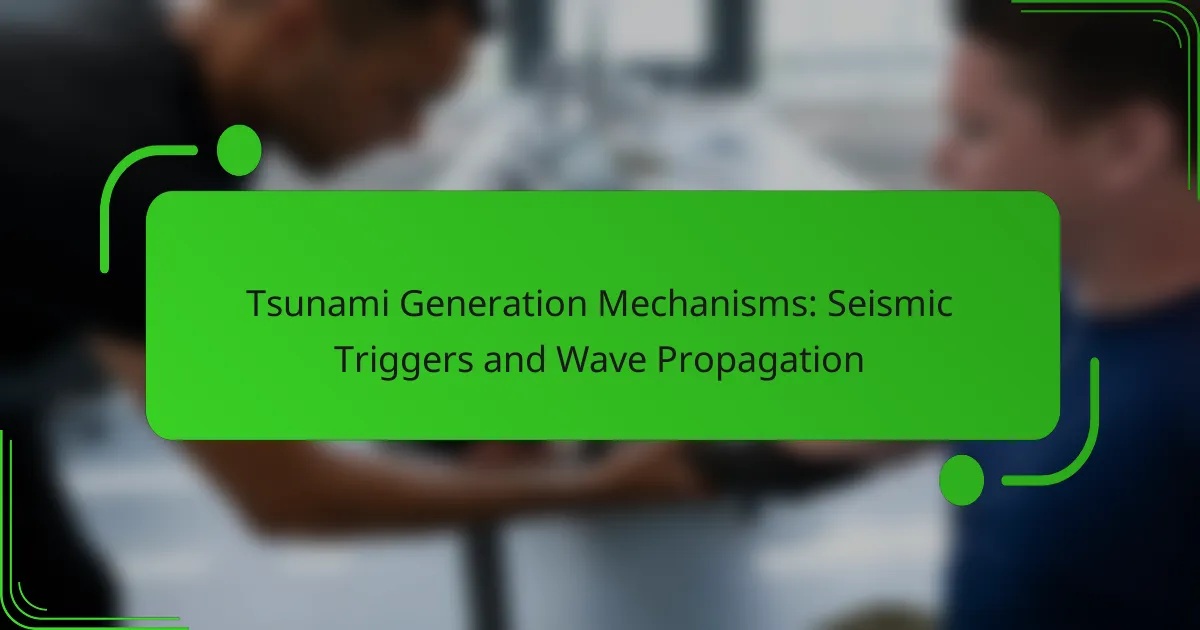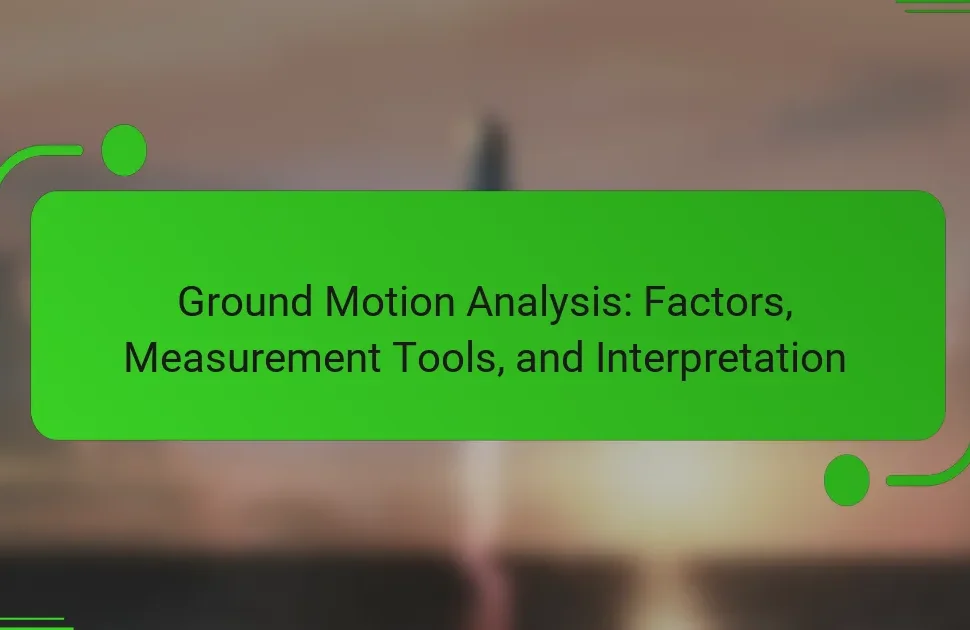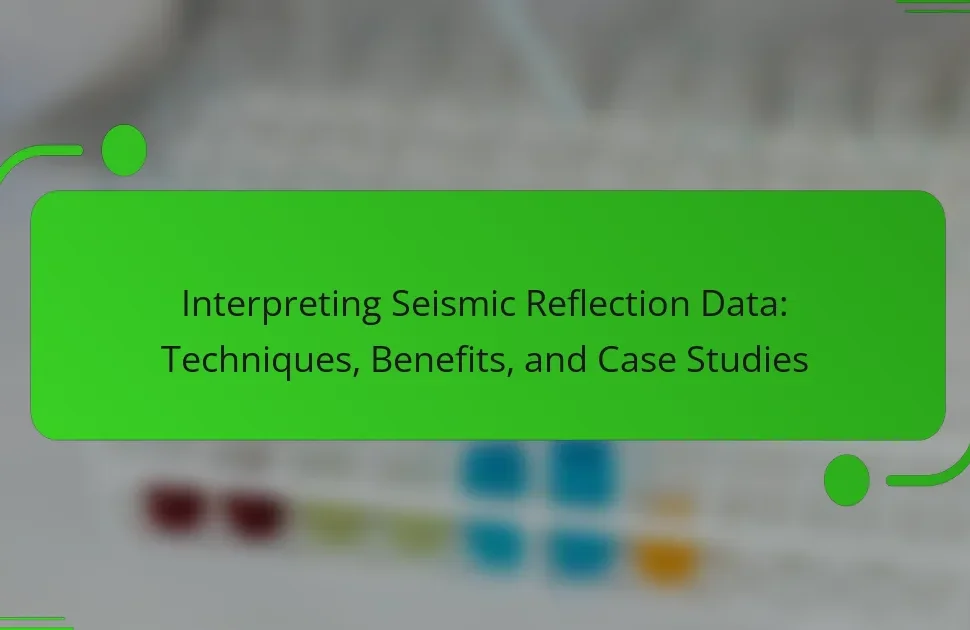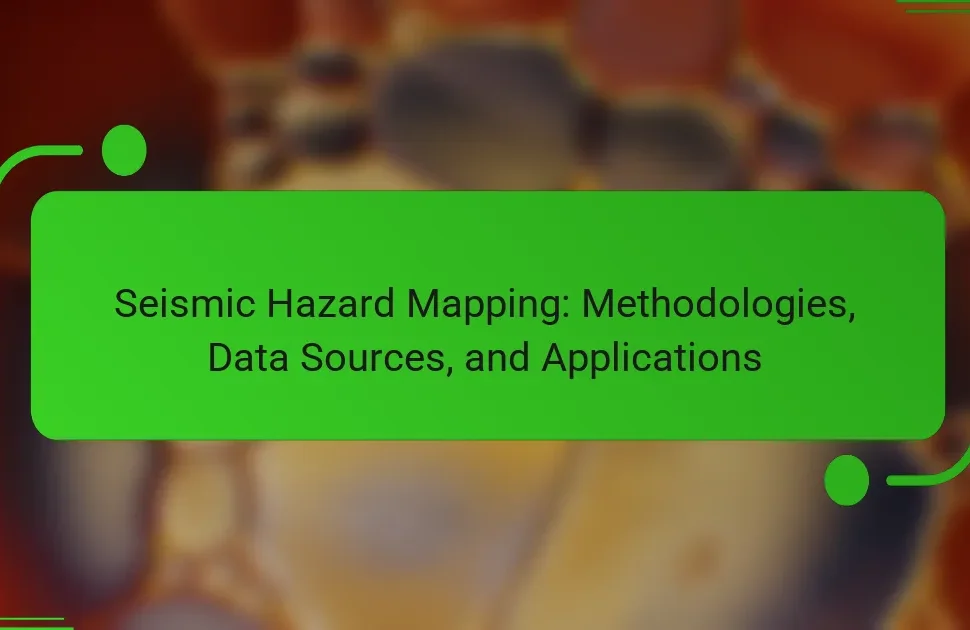Tsunami generation mechanisms encompass the processes that produce tsunamis, primarily through underwater earthquakes, volcanic eruptions, and landslides. Underwater earthquakes are responsible for approximately 80% of tsunamis, displacing large volumes of water and creating waves that can travel across vast ocean distances. This article examines the dynamics of tsunami wave propagation, highlighting the speed and height changes as tsunamis approach shorelines. It also discusses the devastating consequences of tsunamis, including extensive flooding, loss of life, economic impacts, and environmental damage, with historical examples such as the catastrophic 2004 Indian Ocean tsunami illustrating these effects.
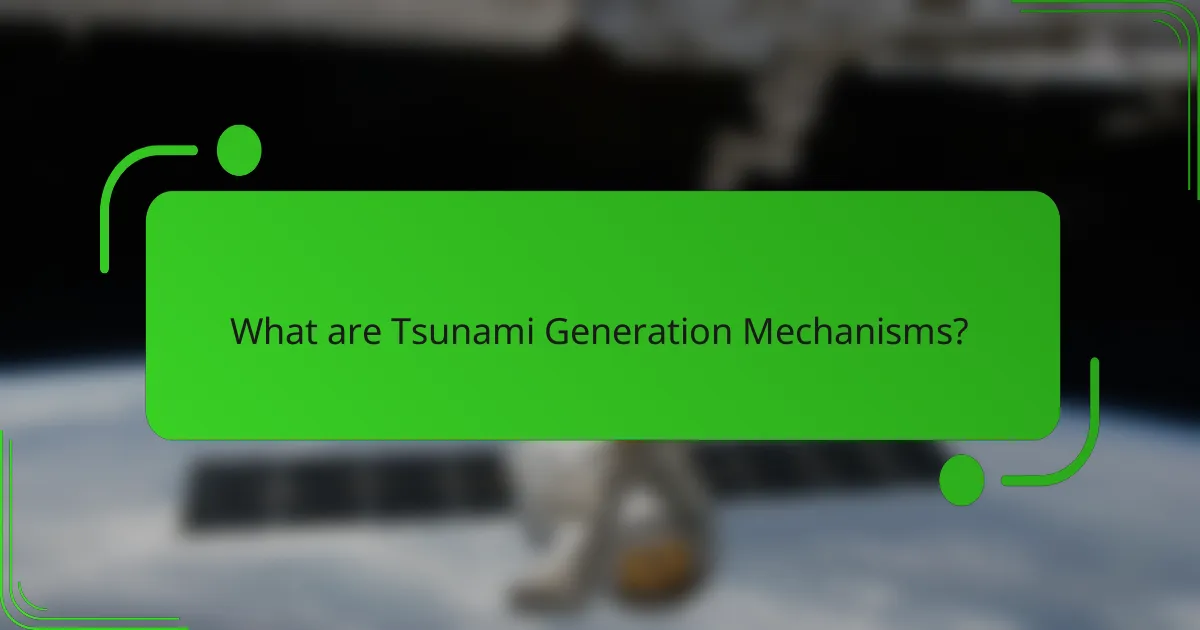
What are Tsunami Generation Mechanisms?
Tsunami generation mechanisms refer to the processes that produce tsunamis. The primary mechanisms include underwater earthquakes, volcanic eruptions, and landslides. Underwater earthquakes account for approximately 80% of tsunamis. These seismic events displace large volumes of water, creating waves that can travel across oceans. Volcanic eruptions can also cause tsunamis through explosive activity or the collapse of volcanic islands. Landslides, both underwater and terrestrial, can generate tsunamis by rapidly displacing water. Historical data shows that the 2004 Indian Ocean tsunami was triggered by a massive undersea earthquake. This event exemplifies how seismic activity can lead to devastating tsunami waves.
How do seismic events trigger tsunamis?
Seismic events trigger tsunamis primarily through underwater earthquakes. These earthquakes displace large volumes of water, creating waves that propagate outward. The magnitude and depth of the earthquake influence the tsunami’s size and speed. For example, earthquakes of magnitude 7.5 or greater are often responsible for significant tsunamis. When the ocean floor shifts abruptly, it can lift or lower the water column above it. This displacement generates waves that can travel across entire ocean basins. Historical events, such as the 2004 Indian Ocean earthquake, demonstrate this mechanism effectively. The 2004 earthquake had a magnitude of 9.1 and resulted in devastating tsunamis impacting multiple countries.
What types of seismic events are most commonly associated with tsunamis?
Earthquakes are the most common seismic events associated with tsunamis. Specifically, undersea earthquakes that occur along tectonic plate boundaries often generate tsunamis. The magnitude of these earthquakes typically exceeds 6.5 on the Richter scale. Subduction zones, where one tectonic plate moves under another, are particularly prone to such earthquakes. Historical examples include the 2004 Indian Ocean earthquake and the 2011 Tōhoku earthquake in Japan. Both events triggered massive tsunamis, causing significant destruction. Additionally, volcanic eruptions and landslides can also generate tsunamis, although they are less common. These seismic events disrupt the water column, leading to the formation of tsunami waves.
How do underwater earthquakes lead to wave generation?
Underwater earthquakes lead to wave generation by displacing large volumes of water. This displacement occurs when tectonic plates shift along faults beneath the ocean floor. The sudden movement creates a vertical change in the seabed. This vertical change pushes water upward, generating waves.
These waves can travel across vast distances. The energy from the earthquake is transferred to the water, forming tsunamis. Historical events, such as the 2004 Indian Ocean earthquake, illustrate this process. The earthquake had a magnitude of 9.1 and triggered devastating tsunamis that affected multiple countries.
What role does plate tectonics play in tsunami generation?
Plate tectonics plays a crucial role in tsunami generation. Tsunamis are often triggered by underwater earthquakes caused by the movement of tectonic plates. These earthquakes typically occur at subduction zones, where one plate moves beneath another. The sudden release of energy in these zones displaces large volumes of water, creating waves. Historical data shows that over 80% of tsunamis are linked to seismic activity along tectonic plate boundaries. For example, the 2004 Indian Ocean tsunami was generated by a magnitude 9.1 earthquake along the Sunda Trench, a tectonic plate boundary. Thus, the interaction of tectonic plates is fundamental to the occurrence of tsunamis.
How do tectonic plate movements create conditions for tsunamis?
Tectonic plate movements create conditions for tsunamis primarily through underwater earthquakes. These earthquakes occur when stress builds up along fault lines due to plate interactions. When the stress exceeds the strength of rocks, it results in a sudden release of energy. This release displaces large volumes of water, generating waves that can travel across oceans. The 2004 Indian Ocean earthquake, measuring 9.1, triggered a devastating tsunami that affected multiple countries. The rapid vertical movement of the seafloor during such earthquakes is crucial in tsunami formation. As a result, tectonic activity along subduction zones is particularly significant in tsunami generation.
What are the different types of plate boundaries involved in tsunami generation?
The different types of plate boundaries involved in tsunami generation are convergent, divergent, and transform boundaries. Convergent boundaries occur where tectonic plates collide. This collision can cause significant underwater earthquakes, leading to tsunami generation. Divergent boundaries occur where tectonic plates move apart. This movement can create volcanic activity that may also trigger tsunamis. Transform boundaries are where plates slide past one another. While less common, significant seismic activity at these boundaries can also result in tsunamis. Historical events, such as the 2004 Indian Ocean tsunami, illustrate the impact of convergent boundaries.
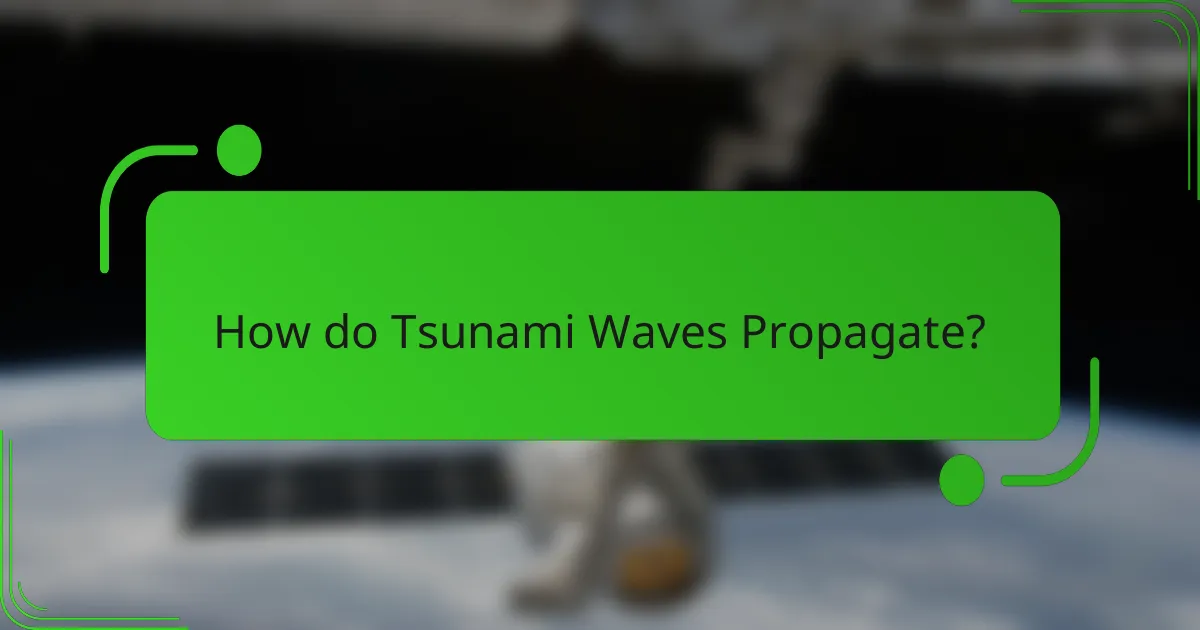
How do Tsunami Waves Propagate?
Tsunami waves propagate through the ocean as a series of long-wavelength waves. These waves are generated by underwater disturbances, primarily seismic activity such as earthquakes. As seismic waves displace large volumes of water, energy travels outward from the source. The speed of tsunami waves can reach up to 500-800 kilometers per hour in deep water. In shallow water, their speed decreases, but their height increases significantly. Tsunami waves can travel across entire ocean basins, affecting distant shorelines. The wave energy is concentrated at the surface, leading to rapid increases in wave height as they approach land. Historical events, such as the 2004 Indian Ocean tsunami, illustrate this propagation pattern and its devastating effects.
What factors influence the propagation of tsunami waves?
Tsunami wave propagation is influenced by several key factors. These factors include the depth of the ocean, the shape of the seafloor, and the initial energy of the tsunami. Deeper waters allow waves to travel faster and with less energy loss. The seafloor’s topography can cause waves to refract, change direction, or increase in height. The initial energy, often from seismic activity, determines the wave’s speed and amplitude. Historical data shows that tsunamis generated by undersea earthquakes can travel across entire ocean basins. The 2004 Indian Ocean tsunami traveled over 5,000 kilometers at speeds up to 800 kilometers per hour. Additionally, coastal features such as bays and estuaries can amplify wave heights upon reaching shore. These factors collectively dictate the behavior and impact of tsunami waves as they propagate.
How does water depth affect wave speed and height?
Water depth significantly affects wave speed and height. In deeper water, waves travel faster due to reduced friction with the seabed. The speed of deep-water waves can be calculated using the formula: speed equals the square root of the product of the gravitational acceleration and the water depth. As waves approach shallower depths, their speed decreases.
In contrast, wave height increases as waves enter shallower waters. This phenomenon occurs because the energy of the wave is compressed into a smaller water column. Research shows that wave height can increase dramatically, sometimes leading to breaking waves or tsunamis when water depth is significantly reduced.
These principles are crucial in understanding tsunami behavior. For instance, a tsunami traveling in deep water can reach speeds of up to 500-800 km/h. However, as it approaches the coast and the water depth decreases, its speed reduces, and height increases, often resulting in devastating impacts.
What is the impact of coastal geography on wave behavior?
Coastal geography significantly influences wave behavior. The shape and slope of the coastline affect how waves break. Steep coastlines tend to produce higher and more powerful waves. Conversely, gentle slopes result in lower waves that dissipate energy over a wider area. Features such as bays and headlands can focus wave energy, leading to stronger wave action in certain areas. Additionally, the presence of underwater topography, like reefs or sandbars, alters wave patterns and energy distribution. Research indicates that these geographical features can amplify wave heights during tsunami events, impacting coastal communities.
How do tsunamis differ from regular ocean waves?
Tsunamis differ from regular ocean waves primarily in their formation and characteristics. Regular ocean waves are generated by wind and typically have a wavelength of a few hundred meters. In contrast, tsunamis are caused by seismic events, such as underwater earthquakes, and can have wavelengths exceeding 100 kilometers.
Regular waves usually travel at speeds of about 5 to 60 kilometers per hour. Tsunamis, however, can travel across entire ocean basins at speeds up to 800 kilometers per hour. The energy of regular waves dissipates quickly in shallow water. Tsunami waves retain their energy over long distances and can increase in height as they approach land.
Additionally, regular waves have a height of a few meters, while tsunamis can reach heights of over 30 meters upon landfall. This significant difference in speed, energy, and height contributes to the destructive potential of tsunamis compared to regular ocean waves.
What are the unique characteristics of tsunami waves?
Tsunami waves have unique characteristics that differentiate them from regular ocean waves. They can travel at speeds exceeding 500 miles per hour in deep water. Unlike typical waves, tsunami waves have long wavelengths, often exceeding 60 miles. Their height in deep water is usually less than a meter, making them hard to detect. As they approach shallow coastal areas, their speed decreases, but their height can increase dramatically. This phenomenon is known as wave shoaling. Tsunami waves can also consist of multiple waves, with the first wave not necessarily being the largest. Historical data shows that the 2004 Indian Ocean tsunami had waves reaching heights of over 100 feet upon landfall. These characteristics contribute to the devastating impact of tsunamis on coastal regions.
How is tsunami energy distributed compared to standard waves?
Tsunami energy is distributed differently than standard wave energy. Tsunami waves carry energy over long distances with minimal loss. In contrast, standard waves dissipate energy quickly due to friction with the ocean surface. Tsunamis have a longer wavelength and travel at higher speeds, often exceeding 500 miles per hour in deep water. This allows them to distribute energy over vast ocean areas. Standard waves have shorter wavelengths, typically under 100 meters, and their energy is concentrated in the upper layers of the ocean. When tsunamis approach shallow coastal areas, their energy compresses, increasing wave height dramatically. This phenomenon can cause devastating impacts upon reaching land.
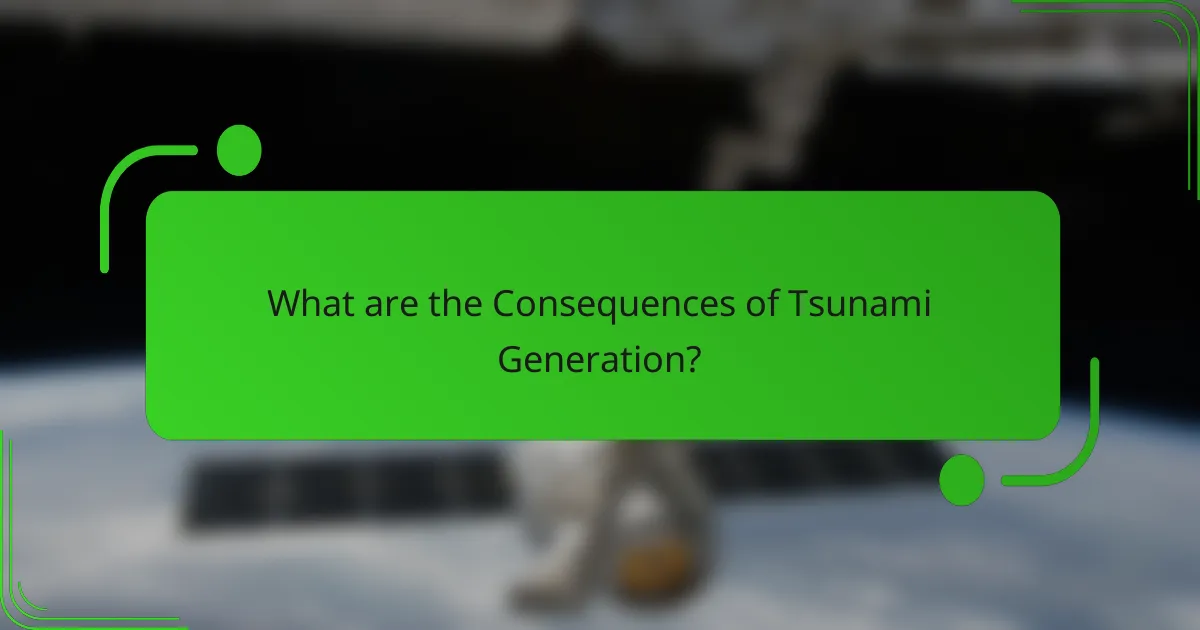
What are the Consequences of Tsunami Generation?
Tsunami generation leads to devastating consequences for coastal regions. The primary consequence is extensive flooding, which can inundate land and destroy infrastructure. Historical events, such as the 2004 Indian Ocean tsunami, resulted in over 230,000 fatalities and immense property damage. Tsunamis also cause loss of life due to drowning and injuries from debris. Additionally, they can trigger secondary disasters like fires and landslides. Economic impacts are severe, with costs in the billions for recovery and rebuilding. Environmental damage occurs as ecosystems are disrupted and contaminated by saltwater. Long-term consequences include displacement of communities and psychological trauma for survivors.
How do tsunamis impact coastal communities?
Tsunamis significantly impact coastal communities by causing widespread destruction and loss of life. The immense waves can inundate coastal areas, leading to property damage and displacement. Historical events, such as the 2004 Indian Ocean tsunami, resulted in over 230,000 fatalities and millions displaced. Tsunamis can destroy infrastructure, including roads, bridges, and utilities, disrupting essential services. Economic losses can reach billions of dollars due to repair costs and loss of tourism. The psychological effects on survivors include trauma and long-term mental health issues. Coastal communities often face challenges in rebuilding and recovery, affecting their resilience and future preparedness.
What are the immediate dangers posed by tsunami waves?
Tsunami waves pose immediate dangers such as flooding, strong currents, and debris impact. Flooding can inundate coastal areas, causing property damage and loss of life. Strong currents can sweep away people and objects, leading to drowning. Debris carried by the waves can cause injuries and fatalities. Historical data shows that the 2004 Indian Ocean tsunami resulted in over 230,000 deaths due to these dangers. Immediate evacuation is crucial to minimize risks during a tsunami event.
How do tsunamis affect infrastructure and ecosystems?
Tsunamis severely damage infrastructure and disrupt ecosystems. They can obliterate buildings, roads, and bridges, leading to significant economic losses. The 2004 Indian Ocean tsunami destroyed over 100,000 structures in Indonesia alone. Tsunamis also inundate coastal areas, causing erosion and altering landscapes. This flooding can lead to saltwater intrusion, impacting freshwater supplies and agriculture. Ecosystems suffer as marine and terrestrial habitats are destroyed. Aquatic life faces immediate threats from debris and changes in water quality. Recovery of affected areas can take years, highlighting the long-term consequences of tsunami events.
What measures can be taken to mitigate tsunami risks?
To mitigate tsunami risks, communities should implement early warning systems. These systems can detect seismic activity and provide alerts to vulnerable areas. Tsunami education programs are essential for informing the public about evacuation routes and safety measures. Coastal infrastructure should be designed to withstand tsunami impacts, including reinforced buildings and elevated roads. Natural barriers, such as mangroves and coral reefs, can help reduce wave energy. Regular drills and preparedness exercises can enhance community readiness. Historical data indicates that regions with effective warning systems have lower casualty rates during tsunamis. For example, the 2004 Indian Ocean tsunami highlighted the need for improved global coordination in tsunami monitoring and response.
How can early warning systems help save lives during a tsunami?
Early warning systems can significantly save lives during a tsunami by providing timely alerts to at-risk populations. These systems utilize seismic data to detect undersea earthquakes that may trigger tsunamis. When an earthquake is detected, the system quickly analyzes the data and predicts potential tsunami formation. Alerts are then disseminated through various communication channels, including sirens, text messages, and social media.
Research indicates that timely warnings can reduce casualties by allowing people to evacuate to higher ground. For instance, the Indian Ocean tsunami in 2004 resulted in over 230,000 deaths, highlighting the need for effective warning systems. In contrast, the 2011 Japan tsunami warning system successfully alerted millions, leading to a swift evacuation that saved thousands of lives.
The effectiveness of early warning systems is further supported by studies showing that communities with established protocols and response plans experience fewer fatalities during tsunamis. Overall, early warning systems are crucial for disaster preparedness and response, directly contributing to saving lives during tsunami events.
What are best practices for tsunami preparedness in coastal areas?
Best practices for tsunami preparedness in coastal areas include developing an emergency plan and conducting regular drills. Communities should establish clear evacuation routes and designate safe zones. Public education on tsunami risks and warning signs is essential. Residents should have emergency kits ready with food, water, and medical supplies. Installing tsunami warning systems can provide timely alerts. Local governments should engage in land-use planning to avoid high-risk areas for development. Historical data shows that areas with preparedness plans have lower casualties during tsunamis. For instance, after the 2004 Indian Ocean tsunami, regions with established evacuation routes saved many lives.
What are the long-term effects of tsunamis on affected regions?
Tsunamis have significant long-term effects on affected regions. They can lead to extensive coastal erosion, altering landscapes permanently. Infrastructure damage is often severe, requiring years for reconstruction. Ecosystems may suffer, with habitats destroyed or altered. Economic impacts persist as fishing and tourism industries may decline. Displacement of populations can occur, leading to long-term social challenges. Contaminated water supplies can affect public health for years. Recovery efforts can take decades, influencing regional development. Historical data shows that areas hit by tsunamis, like the 2004 Indian Ocean tsunami, experienced prolonged recovery periods.
How do recovery efforts shape the future of tsunami-affected areas?
Recovery efforts significantly influence the future of tsunami-affected areas by promoting resilience and sustainable development. These efforts often include rebuilding infrastructure, improving early warning systems, and enhancing community preparedness. For instance, post-tsunami recovery in Japan led to the implementation of advanced tsunami monitoring technologies. This technology reduces the risk of future disasters by providing timely alerts. Additionally, recovery initiatives often focus on restoring ecosystems, which can mitigate future tsunami impacts. Historical evidence shows that areas with robust recovery plans recover more quickly and effectively. The 2004 Indian Ocean tsunami highlighted the importance of community involvement in recovery, leading to stronger local governance in affected regions. Overall, effective recovery efforts shape a safer and more resilient future for tsunami-affected communities.
What role does community resilience play in post-tsunami recovery?
Community resilience plays a crucial role in post-tsunami recovery. It enables communities to effectively respond to and recover from the impacts of a tsunami. Resilient communities can mobilize resources quickly and adapt to changing circumstances. They foster social cohesion, which enhances cooperation during recovery efforts. Studies show that communities with strong social networks recover faster. For instance, research indicates that community engagement significantly reduces recovery time after disasters. Resilience also involves preparedness measures, such as early warning systems and emergency plans. These preparations can save lives and minimize damage. Overall, community resilience is vital for swift and effective post-tsunami recovery.
Tsunami generation mechanisms encompass the processes that produce tsunamis, primarily driven by underwater earthquakes, volcanic eruptions, and landslides. Approximately 80% of tsunamis result from seismic activity, particularly underwater earthquakes along tectonic plate boundaries. The article discusses how these seismic events trigger tsunamis, the propagation of tsunami waves, and the factors influencing their behavior, including ocean depth and coastal geography. It also examines the devastating consequences of tsunamis on coastal communities, infrastructure, and ecosystems, as well as strategies for mitigation and recovery to enhance community resilience.
